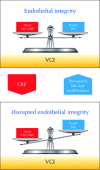Circulating endothelial cells, microparticles and progenitors: key players towards the definition of vascular competence
- PMID: 19379144
- PMCID: PMC3822508
- DOI: 10.1111/j.1582-4934.2008.00639.x
Circulating endothelial cells, microparticles and progenitors: key players towards the definition of vascular competence
Abstract
The balance between lesion and regeneration of the endothelium is critical for the maintenance of vessel integrity. Exposure to cardiovascular risk factors (CRF) alters the regulatory functions of the endothelium that progresses from a quiescent state to activation, apoptosis and death. In the last 10 years, identification of circulating endothelial cells (CEC) and endothelial-derived microparticles (EMP) in the circulation has raised considerable interest as non-invasive markers of vascular dysfunction. Indeed, these endothelial-derived biomarkers were associated with most of the CRFs, were indicative of a poor clinical outcome in atherothrombotic disorders and correlated with established parameters of endothelial dysfunction. CEC and EMP also behave as potential pathogenic vectors able to accelerate endothelial dysfunction and promote disease progression. The endothelial response to injury has been enlarged by the discovery of a powerful physiological repair process based on the recruitment of circulating endothelial progenitor cells (EPC) from the bone marrow. Recent studies indicate that reduction of EPC number and function by CRF plays a critical role in the progression of cardiovascular diseases. This EPC-mediated repair to injury response can be integrated into a clinical endothelial phenotype defining the 'vascular competence' of each individual. In the future, provided that standardization of available methodologies could be achieved, multimarker strategies combining CEC, EMP and EPC levels as integrative markers of 'vascular competence' may offer new perspectives to assess vascular risk and to monitor treatment efficacy.
Figures


References
-
- Landmesser U, Drexler H. Endothelial function and hypertension. Curr Opin Cardiol. 2007;22:316–20. - PubMed
-
- Goligorsky MS. Clinical assessment of endothelial dysfunction: combine and rule. Curr Opin Nephrol Hypertens. 2006;15:617–24. - PubMed
-
- Boos CJ, Lip GY, Blann AD. Circulating endothelial cells in cardiovascular disease. J Am Coll Cardiol. 2006;48:1538–47. - PubMed
-
- Piccin A, Murphy WG, Smith OP. Circulating microparticles: pathophysiology and clinical implications. Blood Rev. 2007;21:157–71. - PubMed
-
- Lynch SF, Ludlam CA. Plasma microparti-cles and vascular disorders. Br J Haematol. 2007;137:36–48. - PubMed
Publication types
MeSH terms
LinkOut - more resources
Full Text Sources
Other Literature Sources
Medical

